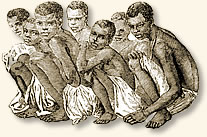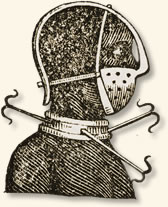|
Slave Trade:
the African Connection, ca 1788
The labor-intensive agriculture of the New World
demanded a large workforce. Crops such as sugar cane, tobacco and cotton required
an unlimited and inexpensive supply of strong backs to assure
timely production for the European market. Slaves from Africa offered the solution.
The slave trade between Western Africa and the America's reached its peak in
the mid-18th century when it is estimated that over 80,000 Africans annually
crossed the Atlantic to spend the rest of their lives in chains. Of those who
survived the voyage, the final destination of approximately 40% was the Caribbean
Islands. Thirty-eight percent ended up in Brazil, 17% in Spanish America and
6% in the United States.
 |
Young boys wait to be loaded
aboard a slave ship |
It was a lucrative business. A slave purchased on the African coast for the equivalent of 14 English pounds in bartered goods in 1760 could sell for 45 pounds in the American market.
A slave's journey to a life of servitude often began in the interior of Africa
with his or her capture as a prize of war, as tribute given by a weak tribal
state to a more powerful one, or by outright kidnapping by local traders. European
slave traders rarely ventured beyond Africa's coastal regions. The African
interior was riddled with disease, the natives were often hostile and the land
uncharted. The Europeans preferred to stay in the coastal region and have the
natives bring the slaves to them.
Dr. Alexander Falconbridge served as the surgeon aboard a number of slave ships that plied their trade between the West African coast and the Caribbean in the late 1700s. He described his experiences in a popular book published in 1788. He became active in the Anti-Slavery Society and was appointed Governor of a colony established for freed slaves on the coast of modern-day Sierra Leone. His service was brief as he died in 1788 shortly after his appointment. We join his story as he describes the process through which the native African looses his freedom:
"There is great reason to believe,
that most of the Negroes shipped off from the coast of Africa, are kidnapped.
But the extreme care taken by the black traders to prevent the Europeans
from gaining any intelligence of their modes of proceeding; the great distance
inland from whence the Negroes are brought; and our ignorance of their language
(with which, very frequently, the black traders themselves are equally unacquainted),
prevent our obtaining such information on this head as we could wish. I have,
however, by means of occasional inquiries, made through interpreters, procured
some intelligence relative to the point. . . . From these I shall select
the following striking instances: While I was in employ on board one of the
slave ships, a Negro informed me that being one evening invited to drink
with some of the black traders, upon his going away, they attempted to seize
him. As he was very active, he evaded their design, and got out of their
hands. He was, however, prevented from effecting his escape by a large dog,
which laid hold of him, and compelled him to submit. These creatures are
kept by many of the traders for that purpose; and being trained to the inhuman
sport, they appear to be much pleased with it.
I was likewise told by a Negro woman that as she was on her return home, one
evening, from some neighbors, to whom she had been making a visit by invitation,
she was kidnapped; and, notwithstanding she was big with child, sold for a
slave. This transaction happened a considerable way up the country, and she
had passed through the hands of several purchasers before she reached the ship.
A man and his son, according to their own information,
were seized by professed kidnappers, while they were planting yams, and sold
for slaves. This likewise happened in the interior parts of the country,
and after passing through
several hands, they were purchased for the ship to which I belonged. It frequently
happens that those who kidnap others are themselves, in their turns, seized
and sold.
. . . During my stay on the coast of Africa, I was
an eye-witness of the following transaction: a black trader invited a Negro,
who resided a little way
up the country, to come and see him. After the entertainment was over, the
trader proposed to his guest, to treat him with a sight of one of the ships
lying in the river. The unsuspicious countryman readily consented, and
accompanied the trader in a canoe to the side of the ship, which he viewed
with pleasure and astonishment. While he was thus employed, some black traders
on board, who appeared to be in the secret, leaped into the canoe, seized the
unfortunate man, and dragging him into the ship, immediately sold him.
The preparations made at Bonny by the black traders,
upon setting out
for the fairs which are held up the country, are very considerable. From
twenty to thirty canoes, capable of containing thirty or forty Negroes each,
are assembled for this purpose; and such goods put on board them as they expect
will be wanted for the purchase of the number of slaves they intend to buy.
When their loading is completed, they commence
their voyage, with colors flying, and music playing; and in about ten or
eleven days, they generally return to Bonny with full cargoes. As soon as the canoes arrive at
the trader's landing place, the purchased Negroes are cleaned, and oiled with
palm-oil; and on the following day they are exposed for sale to the captains.
 |
A device used to control
unruly slaves |
When the Negroes, whom the black traders have to dispose
of, are shown to the European purchasers, they first examine them relative
to their age. They then minutely inspect their persons, and inquire into
the state of their health, if they are afflicted with any infirmity, or are
deformed, or have bad eyes or teeth; if they are lame, or weak in their joints,
or distorted in the back, or of a slender make, or are narrow in the chest;
in short, if they have been, or are afflicted in any manner, so as to render
them incapable of much labor; if any of the foregoing defects are discovered
in them, they are rejected. But if approved of, they are generally taken
on board the ship the same evening. The purchaser has liberty to return on
the following morning, but not afterwards, such as upon re-examination are
found exceptionable.
The traders frequently beat those Negroes which are objected to by the captains,
and use them with great severity. It matters not whether they are refused on
account of age, illness, deformity, or for any other reason. At New Calabar,
in particular . . . the traders, when any of their Negroes have been objected
to, have dropped their canoes under the stern of the vessel, and instantly
be headed them, in sight of the captain.
As soon as the wretched Africans,
purchased at the fairs, fall into the hands of the black traders, they experience
an earnest of those dreadful sufferings which they are doomed in future to
undergo. . . . They are brought from the places where they are purchased to Bonny, etc. in canoes; at the bottom of which
they lie, having their hands tied with a kind of willow twigs, and a strict
watch is kept over them. Their usage in other respects, during the time of
the passage, which generally lasts several days, is equally cruel. Their allowance
of food is so scanty, that it is barely sufficient to support nature. They
are, besides, much exposed to the violent rains which frequently fall here,
being covered only with mats that afford but a slight defense; and as there
is usually water at the bottom of the canoes, from their leaking, they are
scarcely ever dry."
References:
This eyewitness account appears in Falconbridge, Alexander, An Account of the Slave Trade on the Coast of Africa (1788); Curtin, Phillip D. Atlantic Slave Trade (1969); Matheson, William Law, Great Britain and the Slave Trade, 1839-1865 (1967).
How To Cite This Article:
"Slave Trade: the African Connection, ca 1788" EyeWitness to History, www.eyewitnesstohistory.com
(2007).
|






